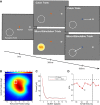Microstimulation of area V4 has little effect on spatial attention and on perception of phosphenes evoked in area V1
- PMID: 25392172
- PMCID: PMC4312861
- DOI: 10.1152/jn.00645.2014
Microstimulation of area V4 has little effect on spatial attention and on perception of phosphenes evoked in area V1
Abstract
Previous transcranial magnetic stimulation (TMS) studies suggested that feedback from higher to lower areas of the visual cortex is important for the access of visual information to awareness. However, the influence of cortico-cortical feedback on awareness and the nature of the feedback effects are not yet completely understood. In the present study, we used electrical microstimulation in the visual cortex of monkeys to test the hypothesis that cortico-cortical feedback plays a role in visual awareness. We investigated the interactions between the primary visual cortex (V1) and area V4 by applying microstimulation in both cortical areas at various delays. We report that the monkeys detected the phosphenes produced by V1 microstimulation but subthreshold V4 microstimulation did not influence V1 phosphene detection thresholds. A second experiment examined the influence of V4 microstimulation on the monkeys' ability to detect the dimming of one of three peripheral visual stimuli. Again, microstimulation of a group of V4 neurons failed to modulate the monkeys' perception of a stimulus in their receptive field. We conclude that conditions exist where microstimulation of area V4 has only a limited influence on visual perception.
Keywords: area V1; area V4; cortico-cortical feedback; phosphenes; visual awareness; visual cortex.
Copyright © 2015 the American Physiological Society.
Figures




References
-
- Bullier J, McCourt ME, Henry GH. Physiological studies on the feedback connection to the striate cortex from cortical areas 18 and 19 of the cat. Exp Brain Res 70: 90–98, 1988. - PubMed
-
- Butovas S, Schwarz C. Spatiotemporal effects of microstimulation in rat neocortex: a parametric study using multielectrode recordings. J Neurophysiol 90: 3024–3039, 2003. - PubMed
-
- Dai J, Brooks DI, Sheinberg DL. Optogenetic and electrical microstimulation systematically bias visuospatial choice in primates. Curr Biol 24: 63–69, 2014. - PubMed
Publication types
MeSH terms
LinkOut - more resources
Full Text Sources
Other Literature Sources

